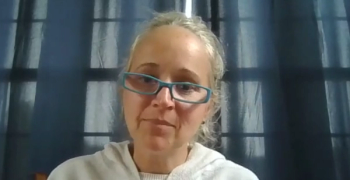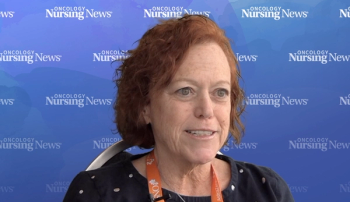
Videos




Dr. Mikhael and Dr. Rossi discuss the safety profiles of CAR-T therapies for multiple myeloma, focusing on common and impactful adverse events, comparisons between ide-cel and cilta-cel, alignment with clinical trial data, and how safety considerations influence treatment selection for diverse patient populations.

This segment explores the treatment journey of a 55-year-old mother and high school teacher with ALK-positive NSCLC and brain metastases, focusing on her experience with lorlatinib therapy.

Panelists discuss how Brandi first noticed symptoms leading to her paroxysmal nocturnal hemoglobinuria (PNH) diagnosis, highlighting the challenges of the initial diagnostic process, and explore the impact of fatigue and brain fog on her daily life. They also address how clinicians assess the severity of these symptoms during consultations and what they indicate about disease progression or treatment needs.

“You can control where you focus your attention,” said Anne M. Reb, PhD, NP, who recently presented on a nurse-led intervention for patients who experience fear of cancer recurrence.

Patients with breast cancer who are of childbearing age may face issues that are accentuated by their age, an expert explained.

Panelists conclude by discussing the future of graft-versus-host disease management, expressing their hopes for the current treatment landscape and potential advancements that could further improve patient outcomes and quality of life.

Panelists discuss how axatilimab, a novel therapy for chronic graft-versus-host disease (cGVHD), functions through a unique mechanism of action compared to other treatments, highlighting its potential role in cGVHD management and presenting key findings from the AGAVE-201 trial that demonstrate its efficacy and safety profile.

Panelists discuss how the current treatment landscape for chronic graft-versus-host disease includes a range of immunosuppressive approaches, from traditional corticosteroids and calcineurin inhibitors to newer approved agents like axatilimab, ruxolitinib, belumosudil, ibrutinib, and abatacept, emphasizing key considerations patients should be aware of when undergoing these therapies.

Panelists discuss how physician assistants educate and empower chronic graft-versus-host disease patients and their caregivers to recognize, report, and manage symptoms effectively, detailing strategies for patient communication, developing personalized symptom management plans, addressing challenging symptoms, and collaborating with the broader healthcare team to ensure comprehensive care.

Panelists discuss how the care team identifies and manages symptoms in chronic graft-versus-host disease patients, particularly those with advanced disease, emphasizing key symptoms to monitor, approaches to symptom identification, and the critical importance of early detection and management for improving patient outcomes.

Panelists discuss how chronic graft-versus-host disease typically progresses in patients requiring third-line treatment and beyond, focusing on severe symptoms, the impact on quality of life, and potential long-term consequences of inadequately managed symptoms.

Panelists discuss how nurse practitioners educate patients about chronic graft-versus-host disease (cGVHD) and its long-term effects, exploring various educational resources and materials such as brochures, apps, websites, and videos that are most effective in supporting patients and their caregivers.

Panelists discuss how chronic graft-versus-host disease (cGVHD) differs from acute GVHD, its main challenges for patients, and its common symptoms and impact on daily life.

Michael Lai, ARNP, explained the mechanism of action of PARP inhibitors for the treatment of patients with prostate cancer.

The Immune Effector Cell Encephalopathy score and keeping a close eye on patients’ symptoms are critical when monitoring for potential ICANS during lymphoma treatment.

A multidisciplinary approach to adverse effect management addresses many needs patients with gynecologic cancers may have while undergoing treatment.

Applying diversity, equity, and inclusion to cancer clinics can help oncology nurses and APPs make an impact on patient care and research.

An expert explained how oncology nurses and APPs should stay informed on the latest genetic mutations that targeted therapies focus in on for non-small cell lung cancer.

An expert discusses recent advancements in breast cancer treatment, focusing on the addition of CDK4/6 inhibitors for high-risk ER-positive, HER2-negative breast cancer.

Meaghan Mooney, B.S.N., RN, OCN, discusses the steps she takes to be an extraordinary healer every day and offers advice for newer oncology nurses.

After reviewing the evidence, nurses switched from heparin-based flushes to all saline flushes for patients disconnecting chemotherapy at home.

An oncology nurse explains how her institution created a surgical path card that improved wait times and patient satisfaction in adults undergoing cancer surgery.

Advanced practice providers can lead clinical teams and patients to boost oncology clinical trial enrollment, a nurse practitioner explained.

The establishment of a multidisciplinary committee can help identify opportunities to best face the ongoing cancer drug shortage.

Patients with myelofibrosis should reflect on their personal priorities and quality of life goals, understand the range of available JAK inhibitor treatment options, and openly communicate with their doctor to arrive at a shared decision for managing their disease.

For most JAK inhibitors dosing starts at the maximum safe dose, while ruxolitinib often requires lower initial doses and dose reductions over the first 12 weeks when cytopenias typically worsen before partially improving, warranting consideration of earlier switching to alternative JAK inhibitors instead of pushing through transfusions.

Reasons to switch JAK inhibitors include worsening blood counts and insufficient symptom or spleen response at maximum doses, with the goal of avoiding gaps in treatment by stopping one JAK inhibitor when ready to start the next to prevent symptom rebound while still allowing for potential increased efficacy from an alternative mechanism of action.

